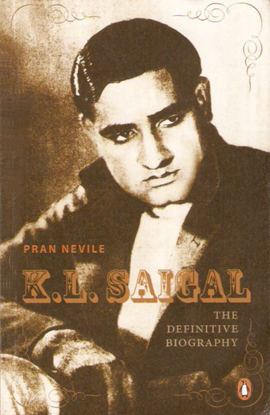Great musical genius K. L. Saigal: The Definitive Biography
By Pran Nevile.
Penguin.
Pages 218. Rs 299.
Reviewed by Kanchan Mehta
LEGENDARY artiste K. L. Saigal reached the pinnacle of his career without any formal training. He is a shining example of how talent, passion and ceaseless practice are essential ingredients for success in singing career. This book pays a tribute to him, highlighting his many accomplishments and valuable contributions. The Indian music industry is indebted to the pathfinder artiste for "the introduction and popularisation of film songs to the Indian public". Such was the impact of his mellifluous voice that his songs, heralding a new era in film music, were acclaimed as "people’s music". Saigal sang in variety of styles and languages—Bengali, Punjabi, Tamil, Hindi, Urdu and Persian. His self-composed devotional melodies turned him into a household name of his time.
Pran Nevile’s considerable expertise in Indian art and culture makes him fit to write about Saigal, whose key role in the history of Indian music and cinema leaves him a force to be reckoned with. The insightful "Introduction" describes the evolution of Indian music and cinema in outline, till the advent of phenomenal artiste, Saigal.
 The sub-title of the book deserves special attention, as the word "definitive" literally means the best and the final. And the present biography is probably one of its kind, since it covers the various facets of versatile artiste—the singer, actor, poet, composer and person. Besides, to compensate for dearth of written record of Saigal’s life, it draws upon recollections of his kith and kin, few pieces of writing on him, synopsis of his famous films, select reviews of his films, his heroines, transcription of his memorable songs, extensive illustrations and the writer’s personal memories. Hence we are given an exhaustive account of Saigal’s life and works.
The sub-title of the book deserves special attention, as the word "definitive" literally means the best and the final. And the present biography is probably one of its kind, since it covers the various facets of versatile artiste—the singer, actor, poet, composer and person. Besides, to compensate for dearth of written record of Saigal’s life, it draws upon recollections of his kith and kin, few pieces of writing on him, synopsis of his famous films, select reviews of his films, his heroines, transcription of his memorable songs, extensive illustrations and the writer’s personal memories. Hence we are given an exhaustive account of Saigal’s life and works.
However, eulogising Saigal as a "Ghazal King", the writer foregrounds his (Saigal’s) remarkable talent and contribution to ghazal singing, overshadowed by his fame as a singer of film songs and bhazans. The lovers of ghazal may find it astonishing that Saigal, ghazal singing was not very popular because there was the general impression that the singing would overshadow the meaning of the verses by distracting listeners to focus on the musical content. Saigal was the first artiste to dispel this notion by joining music to poetry".
Moreover, as recorded in the chapter "Saigal’s Ghalib", through his mesmeric rendition of the classic poet, Mirza Ghalib’s ghazals, Saigal promoted the poet, making him accessible to the audience not well versed in Urdu. Again, the philosophy of Ghalib had a profound impact on Saigal which is evidenced by his (Saigal) indifference to wealth, fame and addiction to alcohol to stimulate his genius. In a word, Ghalib was the idol of Saigal.
As a matter of fact, Saigal was the model of modesty. "If anyone applauded him on his songs, he would laugh it away and retort, ‘Kerah koi sher mar laya, ik geet ee gaya na, chhad yaar’ (I have not killed a loin, just a song, forget about it)". These lines, from the chapter "The Artiste and the Man", encapsulate Saigal’s approach to life. A rare combination of modesty and accomplishment he was indeed!
The chapter "Saigal and the Kotha Culture" reveals that Saigal’s singing is redolent of kotha-style of professional singing girls, known as baijis, which he frequented in the course of his peripatetic days in Jammu. It also gives us a flavour of kotha culture and a string of portraits of eminent kotha artistes of his time.
Presenting a graphic portrait of the "King of Melody", a role model for the artiste after him, the illustrated book contains a series of sketches of his contemporary artistes and mentors, thereby furnishing the audience with a documentary account of Indian music and cinema of that period. Hence evocative and informative, this revealing insight into the life of the "greatest musical genius of the century" is particularly useful for music and cinema buffs, aspiring artistes, film students and followers of Saigal.
The Tribune: June 26, 2011